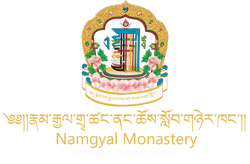The Dalai Lamas

Photo Courtesy of Mark Seliger
The Dalai Lama is a high lama in the Gelug or “Yellow Hat” school of Tibetan Buddhism, founded by Tsongkhapa (1357–1419). The name is a combination of the Sino-Mongolian word dalai meaning “big sea” and the Tibetan word bla-ma meaning “guru, teacher”. According to Tibetan Buddhist doctrine, the Dalai Lama is the rebirth in a line of tulkus who are considered to be manifestations of the bodhisattva of compassion, Avalokiteśvara. The Dalai Lama is often thought to be the leader of the Gelug School, but this position belongs officially to the Ganden Tripa, which is a temporary position appointed by the Dalai Lama who, in practice, exerts much influence. The line of Dalai Lamas began as a lineage of spiritual teachers; the 5th Dalai Lama assumed political authority over Tibet.
For certain periods between the 17th century and 1959, the Dalai Lamas sometimes directed the Tibetan government, which administered portions of Tibet from Lhasa. The 14th Dalai Lama remained the head of state for the Central Tibetan Administration (“Tibetan government in exile”) until his retirement on March 14, 2011. He has indicated that the institution of the Dalai Lama may be abolished in the future, and also that the next Dalai Lama may be found outside Tibet and may be female. The Chinese government rejected this and asserted that only it has the authority to select the next Dalai Lama.
His Holiness the Dalai Lama
The lineage of the Dalai Lamas is the most important spiritual lineage to the Tibetan people and to Tibetan Buddhists in the Himalayan region and throughout the world. The Dalai Lama is recognized to be the earthly manifestation of Avalokiteshvara, the Buddha of compassion. It is believed that this cherished being has been reincarnated again and again for hundreds of years.Our present Dalai Lama, Tenzin Gyatso, is the 14th in this line of succession. Not only has the Dalai Lama served as a spiritual teacher to hundreds of thousands of Tibetan Buddhists, but he has also guided the Tibetan people as a political leader through the tumultuous times of the communist invasion and occupation of Tibet, and through their journey into life in exile.Historically, Namgyal Monastery has had a very intimate relationship with the Dalai Lamas. The original Namgyal was founded in the 16th century by the second Dalai Lama to serve as a training institute for monks. Graduates of Namgyal were trained to assist the Dalai Lama in the many elaborate religious rituals that he performed throughout any given year.
Due to the Chinese communist invasion of Tibet, the Dalai Lama was forced to escape from Lhasa in 1959, at which time he relocated to Dharamsala, India, along with Namgyal Monastery. His Holiness continues to be the spiritual leader not only for Tibetans, but for many Buddhists from all over the world. In 1989, His Holiness was awarded the Nobel Peace Prize for his unwavering commitment to a non-violent resolution with the Chinese government.
The Dalai Lama is the lineage holder of all four schools of Tibetan Buddhism, Sakya, Nying-ma, Kaygu, and Geluk. Although the primary teachings at Namgyal are Geluk, Namgyal Monastery is non-sectarian, and the monks are trained in all schools of Tibetan Buddhism, particularly in the rituals associated with the oldest school of Tibetan Buddhism, the Nying-ma.
The Dalai Lama is known throughout the world as a leading advocate for world peace and non-violence. His message is one of kindness and compassion to all sentient beings. He has met with many leaders and government officials throughout the world to convey his message. The Dalai Lama is held in the highest regard by many in international community for the values he espouses, values which transcend any particular religious affiliation.
Short Biographies of the Previous Dalai Lamas

His Holiness the First Dalai Lama Gedun
Drupa

His Holiness the Second Dalai Lama Gedun Gyatso

His Holiness the Third Dalai Lama Sonam Gyatso

His Holiness the Fourth Dalai Lama Yonten Gyatso

His Holiness the Fifth Dalai Lama Ngawang Lobsang Gyatso

